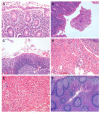Clinical Significance of Variable Histomorphologic Findings Related to Mucosal Inflammation in Negative Appendectomy
- PMID: 34501478
- PMCID: PMC8432450
- DOI: 10.3390/jcm10174030
Clinical Significance of Variable Histomorphologic Findings Related to Mucosal Inflammation in Negative Appendectomy
Abstract
The aim of the study was to investigate the clinical significance of various histomorphologic findings related to mucosal inflammation in negative appendectomy. We reviewed histopathologic findings of 118 negative appendectomies and correlated them with the appendicitis inflammatory response (AIR) score and appendiceal diameter. Among 118 patients with negative appendectomy, 94 (80%), 73 (78%) and 89 (75%) patients displayed mucosal inflammation, high neutrophil score (neutrophil count ≥10/5 high power field and surface epithelial flattening, respectively. Out of 118 patients with negative appendectomy, mucosal inflammation, high neutrophil score and surface epithelial flattening were associated with higher risk group according to the appendicitis inflammatory response (AIR) score (p < 0.05, respectively). In addition, mucosal inflammation, high neutrophil score and surface epithelial flattening were frequently detected in 118 negative appendectomies, compared with 24 incidental appendectomies (p < 0.05, respectively). In an analysis of 77 negative appendectomy patients with appendiceal diameter data available, increased appendiceal diameter was positively correlated with luminal inflammation, high neutrophil score and surface epithelial flattening (p < 0.05, respectively). In conclusion, mucosal inflammation, high neutrophil score and surface epithelial flattening in negative appendectomy may be relevant to patients' signs and symptoms, especially in cases with no other cause of the abdominal pain.
Keywords: appendicitis inflammatory response (AIR) score; high neutrophil score; mucosal inflammation; negative appendectomy; surface epithelial flattening.
Conflict of interest statement
The authors declare no conflict of interest.
Figures


Similar articles
-
The role of the neutrophil-to-lymphocyte ratio in avoiding negative appendectomies.An Pediatr (Engl Ed). 2023 Jan;98(1):12-18. doi: 10.1016/j.anpede.2022.08.005. Epub 2022 Sep 7. An Pediatr (Engl Ed). 2023. PMID: 36088243
-
Mucosal appendicitis: How can it be differentiated from nonappendicitis?Am J Clin Pathol. 2023 Nov 2;160(5):500-506. doi: 10.1093/ajcp/aqad079. Am J Clin Pathol. 2023. PMID: 37477500
-
Trends and Predictors of Pediatric Negative Appendectomy Rates: A Single-Centre Retrospective Study.Children (Basel). 2023 May 15;10(5):887. doi: 10.3390/children10050887. Children (Basel). 2023. PMID: 37238435 Free PMC article.
-
If not appendicitis, then what else can it be? A retrospective review of 1492 appendectomies.Hong Kong Med J. 2010 Feb;16(1):12-7. Hong Kong Med J. 2010. PMID: 20124568 Review.
-
Clinical manifestations of appendiceal pinworms in children: an institutional experience and a review of the literature.Pediatr Surg Int. 2004 May;20(5):372-5. doi: 10.1007/s00383-004-1151-5. Epub 2004 May 13. Pediatr Surg Int. 2004. PMID: 15141320 Review.
Cited by
-
Comparison of Appendicitis Inflammatory Response (AIR) and Lintula scoring systems in diagnosing acute appendicitis among children.J Med Life. 2022 Apr;15(4):443-447. doi: 10.25122/jml-2021-0049. J Med Life. 2022. PMID: 35646183 Free PMC article.
-
Incidental Neoplasm and Histopathological Spectrum of Suspected Acute Appendicitis in Appendectomy Specimen: An Observational Study.JNMA J Nepal Med Assoc. 2025 Mar;63(283):165-169. doi: 10.31729/jnma.8914. Epub 2025 Mar 31. JNMA J Nepal Med Assoc. 2025. PMID: 40656930 Free PMC article.
References
-
- Gopalam P.R., Konidala M.V.S.S. Comparison of acute inflammatory score and Alvarado score in diagnosis of acute appendicitis at a tertiary care hospital. Int. Surg. J. 2017;4:4034–4038. doi: 10.18203/2349-2902.isj20175405. - DOI
LinkOut - more resources
Full Text Sources

